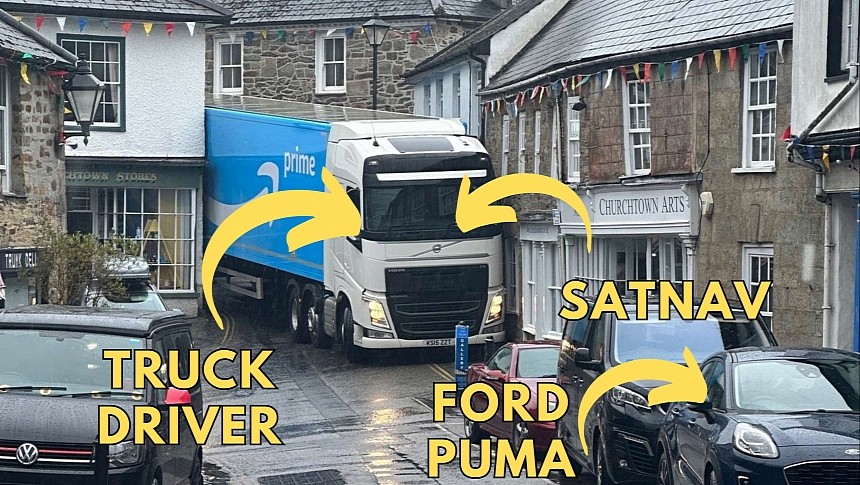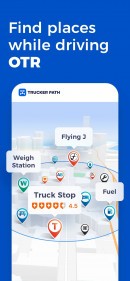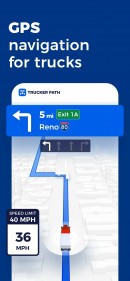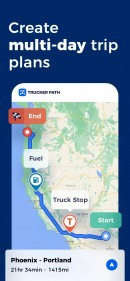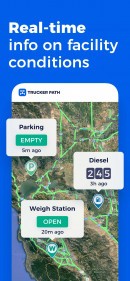Most of us already know that relying entirely on the likes of Google Maps is never a good idea, primarily because the tiniest error in these navigation apps can ruin our day.
However, drivers worldwide continue to trust these solutions blindly, ending up in the most embarrassing and often dangerous situations.
The most recent to learn a very important and painful lesson about Google Maps, Apple Maps, and the other navigation apps on the market is the driver of a 33-tonne Amazon lorry. The driver followed the turn-by-turn guidance on the streets of the seaside village of St. Agnes, Cornwall.
A small village didn't have large roads to handle monster machines, so it was a matter of time until the truck got stuck. Unfortunately, the blunder happened in a place with grade II listed buildings – according to UK classification, the grade II listed building is considered of special interest and must be preserved in its current condition.
It's easy to imagine what happened next. The Amazon driver struggled to get out, and after about 25 minutes of maneuvers, he managed to get free the lorry. The vehicle suffered several scratches and dents, though it's unclear if the buildings were severely damaged.
The driver reportedly blamed the satellite navigation software in the cabin for the blunder, claiming he followed the turn-by-turn guidance to reach the destination.
The navigation software might have caused the incident, but the driver is fully responsible for getting stuck on the narrow roads in a small village. While the local media did not reveal if the driver was using Google Maps, Waze, or other similar apps for route guidance, there are two critical tidbits that every truck driver must keep in mind.
First, Google Maps, Waze, Apple Maps, and other competing products are unsuitable for truck navigation. These applications lack truck support, so their route guidance only supports regular passenger cars without taking into account vehicle dimensions and cargo size when generating routes. When used in a truck, they can send the driver on small roads where a large vehicle wouldn't fit.
Second, even when using dedicated truck navigation, a lorry driver must always pay attention to street signs. Sat-nav solutions aren't always 100 percent accurate and up-to-date, so they might miss important traffic restrictions, eventually sending drivers on incorrect routes. St. Agnes residents claim similar blunders occasionally happen, so the village might lack the proper signage to block large vehicles from entering its small roads.
Amazon has so far remained tight-lipped on the incident, but I don't expect the company to comment on it anyway, especially as the driver is responsible for handling the lorry in the first place. Local authorities haven't commented on any potential damages to the buildings either.
The most recent to learn a very important and painful lesson about Google Maps, Apple Maps, and the other navigation apps on the market is the driver of a 33-tonne Amazon lorry. The driver followed the turn-by-turn guidance on the streets of the seaside village of St. Agnes, Cornwall.
A small village didn't have large roads to handle monster machines, so it was a matter of time until the truck got stuck. Unfortunately, the blunder happened in a place with grade II listed buildings – according to UK classification, the grade II listed building is considered of special interest and must be preserved in its current condition.
It's easy to imagine what happened next. The Amazon driver struggled to get out, and after about 25 minutes of maneuvers, he managed to get free the lorry. The vehicle suffered several scratches and dents, though it's unclear if the buildings were severely damaged.
The driver reportedly blamed the satellite navigation software in the cabin for the blunder, claiming he followed the turn-by-turn guidance to reach the destination.
The navigation software might have caused the incident, but the driver is fully responsible for getting stuck on the narrow roads in a small village. While the local media did not reveal if the driver was using Google Maps, Waze, or other similar apps for route guidance, there are two critical tidbits that every truck driver must keep in mind.
First, Google Maps, Waze, Apple Maps, and other competing products are unsuitable for truck navigation. These applications lack truck support, so their route guidance only supports regular passenger cars without taking into account vehicle dimensions and cargo size when generating routes. When used in a truck, they can send the driver on small roads where a large vehicle wouldn't fit.
Second, even when using dedicated truck navigation, a lorry driver must always pay attention to street signs. Sat-nav solutions aren't always 100 percent accurate and up-to-date, so they might miss important traffic restrictions, eventually sending drivers on incorrect routes. St. Agnes residents claim similar blunders occasionally happen, so the village might lack the proper signage to block large vehicles from entering its small roads.
Amazon has so far remained tight-lipped on the incident, but I don't expect the company to comment on it anyway, especially as the driver is responsible for handling the lorry in the first place. Local authorities haven't commented on any potential damages to the buildings either.
